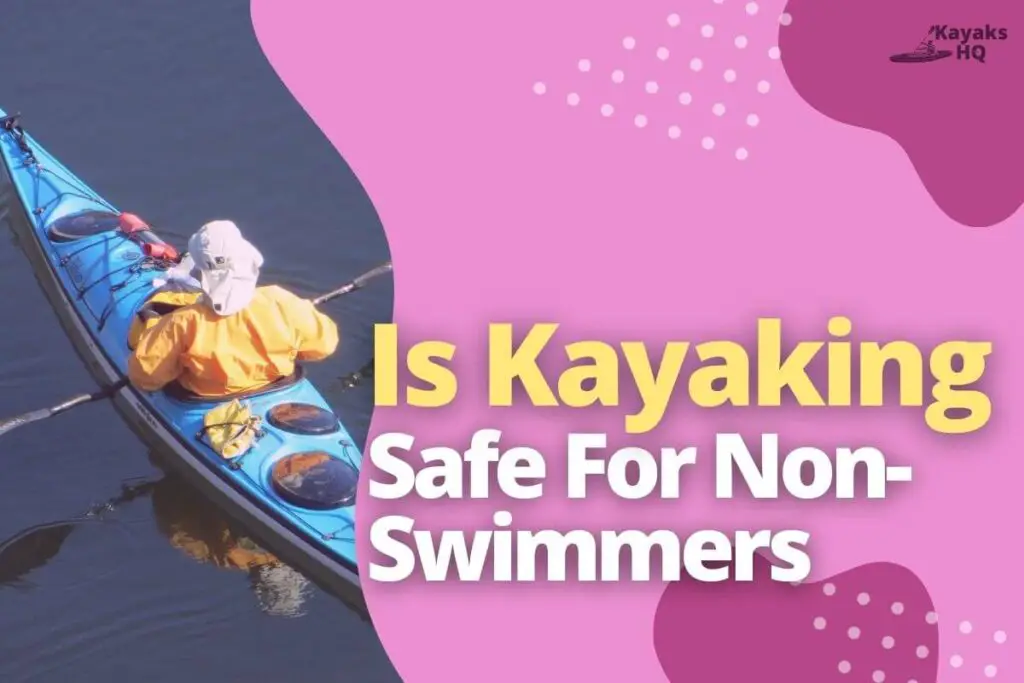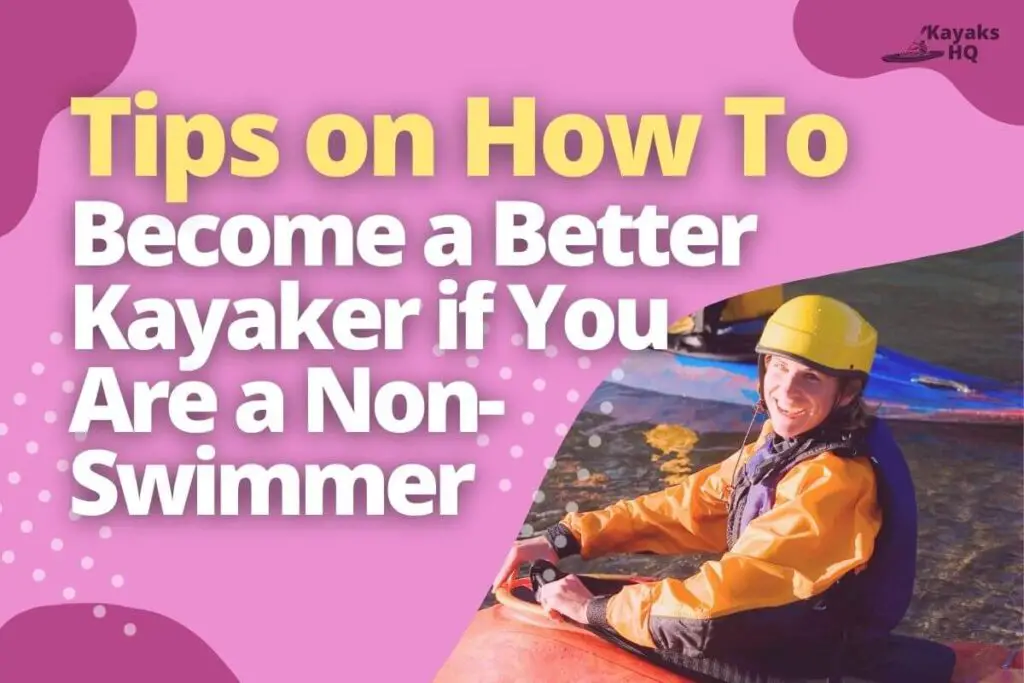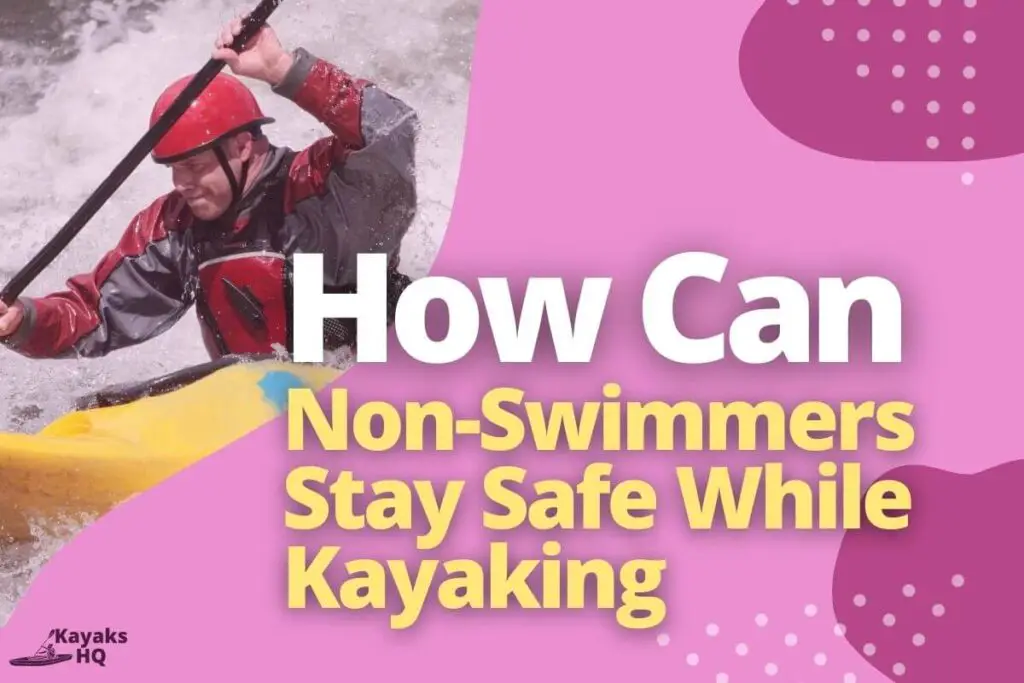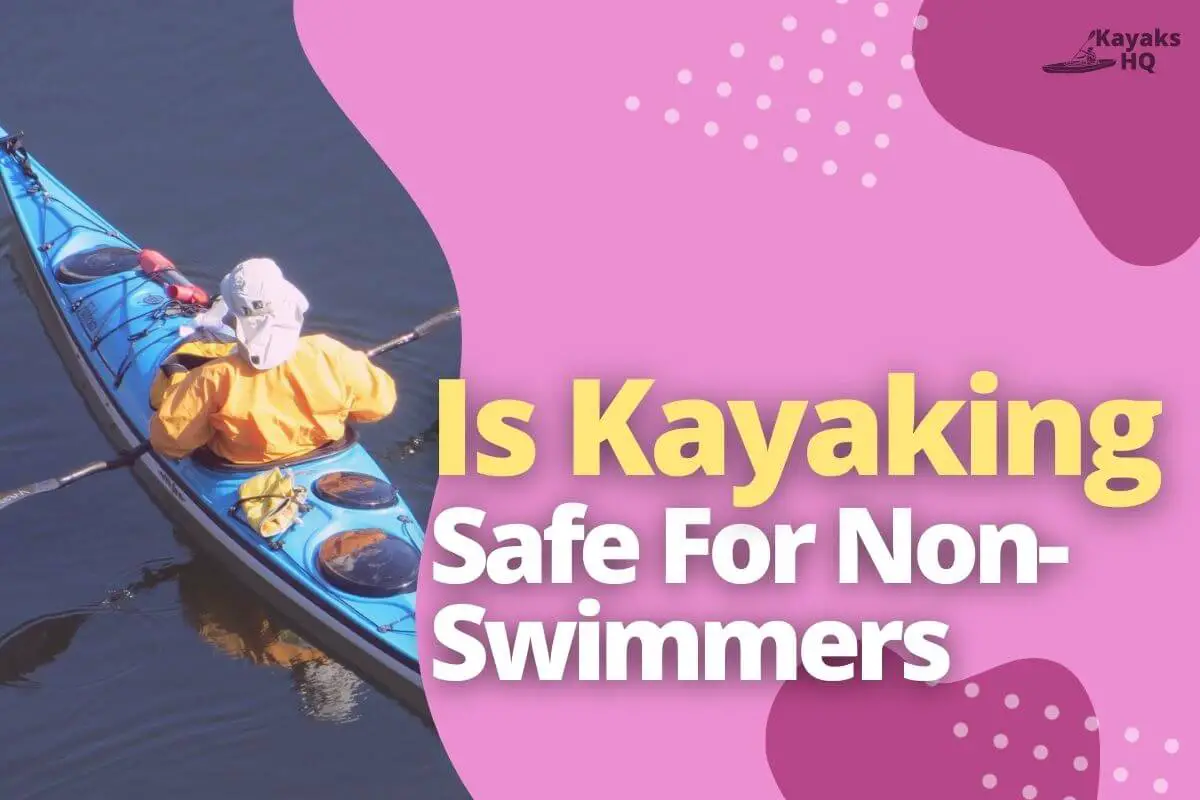Kayaking is an awesome sport, but it’s not for everyone. If you’re interested in learning how to kayak but you’re not a strong swimmer, then you might be wondering if kayaking is safe for non-swimmers.
Kayaking is a great way to enjoy the water and get some exercise. But if you’re not a strong swimmer, should you even consider getting into kayaking?
In this article, we’ll cover why kayaking is safe for non-swimmers and also take a look at some safety tips that will help make your next kayaking trip even safer.

- Here's The Answer To Is Kayaking Safe For Non-Swimmers
- Do People With Poor Swimming Skills Need To Worry About Kayaking?
- Tips on How to Become a Better Kayaker if You Are a Non-Swimmer
- How Can Non-Swimmers Stay Safe While Kayaking?
- Is It Ever Okay For A Non-Swimmer To Go Kayaking Alone?
- Conclusion
- Here's What You Need To Know To Wakesurf Behind an Inboard/outboard Boat:
- Inboards/Outboards Wake Waves
- How Many People Can Ride the Wake from Inboards/Outboards?
- Best Wakesurfing Position
- Choosing Boats For Wakesurfing
- When To Board and When To Stand Up Behind an Inboard/outboard?
- Final Thoughts
Here’s The Answer To Is Kayaking Safe For Non-Swimmers
Kayaking is safe for non-swimmers, but they must take the time to learn how to do it properly. It’s a good idea for anyone to take an introductory lesson before trying kayaking independently.
But it does require you to sit up in the water, which can be challenging for people who are new to this posture. Kayaking is safe because of the limited body exposure and the fact that it’s a seated activity.
You can wear life jackets, too, if you want extra security or reassurance. Kayaking is a great way for non-swimmers to get out on the water. It’s also a sport that can be tailored to your comfort level.
Here are some recommendations for making kayaking safe for those who are unable to swim:
- Start small. If you’re new to both kayaking and swimming, start with one of the inflatable models. This will allow you to get used to paddling around without worrying about tipping over or getting too ambitious with your strokes while in open water.
- Once you feel comfortable using an inflatable kayak, move up in size before trying any other type of vessel like an ocean touring model or sit-in-style boat!
- Use floatation devices when necessary, and always wear a life jacket!
Do People With Poor Swimming Skills Need To Worry About Kayaking?

You do need to be aware of your limitations. This is true with any sport or activity, but especially so for kayaking. At the same time, there are things that you can do to minimize the risk and make your experience fun and safe.
It’s ultimately up to you not to get into situations that could put your life at risk. If you have poor swimming skills, don’t go off alone, especially if there isn’t anyone else around who knows how to swim well enough to rescue you if necessary.
If people with poor swimming skills want to enjoy kayaking anyway:
- Know how far away from shore a rescue team can reach before they start having trouble reaching people who fall overboard due to exhaustion/panic while trying not only to get themselves back onto their capsized boat but also trying simultaneously to keep both themselves as well as their own boats afloat until help arrives;
- Be aware that even if they’re able (or willing), try saving those in distress by bringing them safely back onto land by boat, which could take hours depending on where someone might fall into the water. There may still be other hazards lurking beneath those calm waters like slippery rocks near shorelines or submerged logs lying just below surface level in deeper areas along coastlines;
Is There A Way For Non-Swimmers To Enjoy Kayaking?
If you’re on the fence about learning to kayak, there are a few things you should know.
- Kayaking is fun. It can be even more fun if you have someone to go with!
- Kayaking is good exercise, especially if you use a paddle that helps you move through the water quickly and efficiently.
- Kayaking allows you to get away from everyday life for a little while and enjoy nature in its purest form — or just see some pretty waterfalls (if your favourite lakes or rivers don’t have any).
What Are The Risks Of Kayaking For Non-Swimmers?
Kayaking is a safe activity for non-swimmers if you follow the right safety precautions. Non-swimmers can be at risk of drowning, hypothermia, injury and falling out of the kayak.
There are also risks associated with kayaking that non-swimmers should be aware of:
- Falling on rocks or sharp objects while going down rapids or around rocks in rivers and lakes.
- Getting lost while exploring new places that have never been explored before by kayakers before.
Tips on How to Become a Better Kayaker if You Are a Non-Swimmer

Start by paddling in shallow water. To get used to the kayak and build up your confidence, do this first. You may also want to consider wearing a personal flotation device (PFD) or life vest.
This will help keep you safe in case you capsize or fall out of your kayak.
- Find an experienced friend or fellow kayaker who can help you learn the ropes. Kayaking can be dangerous if you don’t know what you’re doing, so it’s always best to have someone with you who can offer guidance and advice.
- Make sure you choose a stable kayak that is right for your skill level and the water conditions you’ll be paddling in. This is especially important for beginner kayakers. There are many different types of kayaks on the market, so it’s important to do your research and find the one that best suits your needs.
- Taking kayak classes is also a great way to become a better kayaker. This will help you learn the proper techniques and give you the chance to practice in a safe environment. If you’re not sure where to find kayak classes in your area, check with your local recreation centre or search online.
Stamina is another important factor in kayaking. If you’re not used to paddling for long periods of time, you may want to build up your endurance by taking swimming lessons or practising in a swimming pool.
Tips On Buying The Right Kayak As A Non-Swimmer
- Buy a kayak with a seat that has a backrest, footrest, and backrest. This will make it easier for the paddler to get into position and stay there for long periods of time.
- Do your research before buying a kayak. Don’t just go to the first store you see and buy the first one you see on display–many stores only carry one brand of kayaks (which may not be best for you), so I suggest doing some research beforehand to find out what brands are worth looking at and how much they cost.
- Don’t buy from an online retailer unless they have an in-house specialist who can help answer any questions about the equipment they sell (especially if it’s used).
What Are Safety Features Available On A Kayak For Someone Who Doesn’t Swim Well?
Kayaks are made of materials that are buoyant. They also have flotation devices, life jackets, grab lines and spray skirts. If a kayak capsizes or flips over because you don’t know how to swim, you will be safe because the kayak will keep you on top of the water.
Grab lines allow kayakers to hold on to them in case they start to fall off their boats and need some extra support or assistance staying inside the vessel.
Spray skirts keep water out when it is splashed into your vessel while paddling around. Emergency hatches allow people who do not know how to swim to escape underwater if they ever find themselves trapped underneath their vessels!
A whistle is also kept in every kayak so that, hopefully, someone can hear it if there is an emergency at sea!
How Can Non-Swimmers Stay Safe While Kayaking?

You may be wondering how non-swimmers can enjoy the fun, freedom, and adventure of kayaking. The answer is simple: you just need to make sure that you are as safe as possible while kayaking.
- Wear a life jacket. Life jackets help keep you afloat in case something goes wrong, and it gives others peace of mind knowing they have a way to rescue you if necessary.
- Use a rigid seat kayak or sit inside the hull instead of in an open cockpit where there’s less room for manoeuvrability and more exposure to water splashes from paddling strokes or waves hitting from the sides!
You should also consider some other safety tips like using helmets with headlamps on them (to see where you’re going) and wearing vests for additional protection against impact injuries.
Getting dry suits that can help keep warm even when exposed to cold conditions because they keep out moisture/moisture vapour molecules which would normally cause hypothermia problems.
Is It Ever Okay For A Non-Swimmer To Go Kayaking Alone?
You should never go kayaking alone. Even if you are an experienced kayaker, it’s always best to go with a partner. If you don’t know how to swim, then there is no reason for you to be on the water at all; this includes riding in a boat or canoe.
If you are a non-swimmer and want to get into kayaking, make sure that you have someone with experience guiding your first trip out on open water.
What Are Some Other Things You Should Know About Kayaking Safety?

Even if you’re a non-swimmer, it’s important to be safe on the water. Unfortunately, accidents can happen, and no matter how careful you are, sometimes things go wrong. That’s why it’s so important to wear a life jacket when kayaking.
These will help keep you afloat in case of an accident and can also prevent drowning if you happen to fall into deep water.
Other safety precautions include wearing sunscreen and protective clothing such as helmets or stinger suits, depending on where you plan on going, as well as waterproof dry suits if it’s cold outside.
Where Can You Find More Information About Kayaking Safety?
There is a lot of information about kayaking safety online, but it can be hard to find. The best place to look for articles is on the websites of your local kayak shop or your local paddling club.
Your local kayak instructor would also be able to provide some good advice and tips in this area!
Conclusion
In this blog post, we discuss if kayaking is safe for non-swimmers. We also explained how it could help improve their overall health. Additional advice on how to choose a kayak for a non-swimmer has been given.
If you’re interested in kayaking, but you’re worried about its safety of it, you don’t have to be. Kayaking is a great activity for anyone, regardless of their swimming ability. Many non-swimmers enjoy kayaking, and there are many reputable kayaking schools in the U.S. If you’re interested in learning more about kayaking, be sure to check out our website.
We hope you found this blog post helpful! If you’re interested in other blogs on this website, be sure to check them out.
Frequently Asked Questions
What not to try while kayaking as a non-swimmer?
-Paddle too hard or quickly – Going at a fast pace can be dangerous and cause you to lose control of your kayak. Paddling slowly and methodically will help prevent accidents.
-Jump overboard – This could result in you getting wet, cold, lost, or even injured. Before jumping out of the kayak, assess the situation first by looking around for potential hazards like other boats or drowning.
Are there any places where I should not kayak as a non-swimmer?
In general, you should avoid kayaking in rapids or any place where there’s a strong current since you could be easily thrown from your kayak. Always wear a life jacket, even if you’re an experienced kayaker. If your kayak capsizes, swim to shore or stay afloat and signal for help until you are rescued. If you can’t swim, choose a body of water where there are lifeguards on duty.
What are the most common safety concerns with kayaking for non-swimmers?
Kayakers should be aware of their limits and wear life jackets. Also, kayakers need to know the safety concerns surrounding this activity, such as capsizing and the dangers of getting caught in the current.
What are some tips for kayaking with children?
Children of all ages can enjoy kayaking. However, life jackets are recommended for children. It’s important to choose the right kayak for your child and to help them learn how to maneuver the boat safely. Children should also take advantage of a kayak’s stability by sitting upright rather than lying flat on their bellies or backs while paddling.

